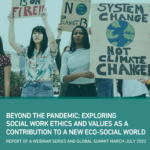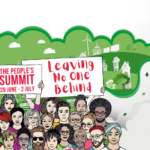Home › Forums › Live Open Mic Forum › Values for transitioning to an eco-social world
- This topic has 25 replies, 14 voices, and was last updated 1 year, 9 months ago by
Rose.
-
AuthorPosts
-
June 29, 2022 at 9:19 am #7051
Rory Truell
KeymasterThe summit process has identified these steering values as a starting point, what others would you suggest need to be included as we move forward?
Buen Vivir, love and care of people and the planet, responsibilities and rights.
Respect, dignity, harmony and justice
Diversity, belonging, reciprocity and equity
Ubuntu, togetherness and communityJune 29, 2022 at 9:27 am #7054simon
ParticipantI think that sometimes we talk about values without ever really being able to state what they are. In working with students its nearly always something that they struggle with and yet its so important.
But what you’ve written and what I’ve heard so far is so beautiful and yet simple and complex all at the same time!
June 29, 2022 at 9:35 am #7057Omar
ParticipantThank you for highlighting this Rory. It is so important to have these steering values. There is so much beauty and value of promoting these core values.
Just a few that come to mind are:
Ikibiri from the Burundian context which refers to bringing people together to do something, as this highlights the improtance of empowering voices to be heard and ensuring collective action which can be seen throughout this People’s Summit, the continued focus on collective action is therefore vital as we move forward
&
Dr Piki Diamond highlighted that ‘Ko au te whenua, te whenua ko au (I am the land and the land is me)’ is an important value for us to reconnect with the land and how we respect, promote and empower good practice in this, and also links in with understanding of land through migration processes and our role as social workers to promote connection with land within complex acculturation experiences, this links in well with co-building an eco-social world and should continue to drive us forward
I am sure there are many others that people may contribute but hoping that these 2 examples prompt some more thinking.
June 29, 2022 at 1:35 pm #7089Lauren
ParticipantThank you Omar and Simon for your comments. If anyone else wishes to add to this discussion, please do!
June 29, 2022 at 3:22 pm #7111Richard
ParticipantI would like to spend more time on these 4 to surface a deeper understanding of their wholistic interconnections and how wholistic (geometric) thinking models may help us away from the linear trap of listing them as if they were separate and inviting suggestions for additional values in the spirit of non-wholistic thinking that a long list of added values guided by part-to-whole thinking will reach a wholistic values set. Whole-to-part thinking would not keep us trapped in a linear, non-wholistic trap while claiming to be wholistic. The notion of wholism will remain significant in rhetoric only. I would like dialogue on rearranging the 4 value sets from a linear list to a geometric tetrahedron-like system that shows the 4 values and their minimum of 6 interconnections in a non-linear and non-hierarchial way. This moves us into 3-D modeling that can also take 2D circle models like indigenous medicine wheel models and “see” them in their 3D wholism too (and I believe, in the way they are meant to be understood). This kind of modelling can expand and contract to undersstand and work with a minimum 4 set or a complex pattern/set of multiple interconnection values understood in the context of whole-to-part thinking instead of our current mostly part-to-whole thinking mindsets that keep us trapped in the rhetoric of wholism and not the practice of wholism. Richard Ramsay
June 29, 2022 at 3:38 pm #7115Richard
ParticipantBuckminster Fuller talked about this kind of kind of individual-collective complementarity and a clear understanding that they go together. Just like concepts of concave-convex, you can’t have one without the other. Fuller was a little wordy in thinking about self-Other. It goes like this. In order to have Self there must be Awareness. To have awareness there must be Other. In reverse thinking, No Other, No Awareness, No Self. Lynn Margulis found individualism to be a separated illusion. Individual-collective are always together, like concave-convex. You can’t separate 1 from the other which is what pre-20th century Western science tried to do with mind-body separation, observer-object separation (so-called objectivity). Giving in and following this kind observer objectivity has been disastrous in Western style social work and the spreading effect it has had on social work teaching and practice over the last 125 years
June 29, 2022 at 5:15 pm #7118Qiancheng
ParticipantI find it hard to summarize my values in one word, but I have three words instead.
These are: Visible, Comprehensible, and ChangeableVisible
Social inequities are not confined to certain settings. Inequities can be seen across geographical regions, across demographic groups, across disciplines or fields of study, and across generations. There are underprivileged populations in the Global North, and there are overprivileged people who own a significant level of power in the Global South. These inequalities can not be changed without them being visible. The invisible populations, taking South-South migrant workers and people with borderline disabilities who I personally focus on for instance, may be neglected from assistance and attention, suffering from insufficient access to care.
On the other hand, changes and improvements should be acknowledged. Thanks to local and international collaborations, life expectancies, vaccination rates among newborns, and access to technology have been improved in almost every country in the world, especially during the past few decades. Even though the world is still full of problems, we, as humans, should be able to see the positive changes we have made, and be proud of ourselves in some ways.Comprehensible
To understand the (emerging) social problems, we need to know what these problems exactly are, what are the root causes, and what/who plays a role in these situations. Most of the time, the problems may seem extremely complicated, and it takes forever to get the full picture. But same as in almost any other scientific field, we should keep learning and keep understanding.Changeable
It can be quite common to be overly optimistic or overly pessimistic about certain situations, but the more we know about them, the more solutions we will have. Since the outbreak of the pandemic, we have had a new level of awareness of the importance of global coalitions and cross-national support. With our collective wisdom, group effort, and updated mindsets, positive changes can be made for the future generations on this planet.I don’t know if I illustrated my points well enough, but these are my takes on the topic 🙂
June 29, 2022 at 7:06 pm #7132Brittnee
ParticipantThank you Richard and Qiancheng for your valuable contributions to this discussion and follow-up thoughts from today’s sessions! The values outlined: visible, changeable, and comprehensible, are certainly relevant to the themes of the summit overall and aims that are important when addressing issues of social change. Does anyone else have themes or values they would like to contribute that came to mind in the sessions today?
June 30, 2022 at 4:46 am #7161Rory Truell
KeymasterDear Omar, I think what you have said and the direction you propose is really great. Wouldn’t it be wonderful have a much broader set of key values that we can learn from and become stronger and more inclusive as a result, just as the social work profession learnt so much when setting Ububtu as the main international theme last year. In that instance, the IFSW African region proposed the theme and guided the global profession in understanding its meanings. My sense is that we as global professions, networks, etc, that are not steeped in specific cultural understandings, we would need to engage our partners and contacts in that cultural base for permission and guidance. As you mention, in the UNESCO RILA session yesterday, Piki acted as a guide on several on several Māori principles. The IFSW members in Aotearoa could also give guidance, and I am aware that The WFPHAs (the health professions in this summit) also have strong connections in Aotearoa as does IASSW. This could be a major learning process for global bodies who have tended to rest on Western values, sometimes with dire consequences. I am really pleased that the summit has identified what we are doing as a ‘living process’ and hope that as we move forward, all cultures will be able to look at what is being done and say, ‘an important aspect of our cultural wisdom is reflected in that’.
June 30, 2022 at 9:11 am #7179Sarah
ParticipantThis is quite a challenge Richard! Sounds like you are good at multi-dimensional, holistic thinking. it would be great to see such a model
June 30, 2022 at 7:18 pm #7235Richard
ParticipantI’ve been tied up with some other things today (in Calgary and MTN time zone). I want to get back to sarah’s and share more about wholism and dimensions (I spell holism more and more with the “w”). I will be able to share text and maybe some graphics to show how I have put systemic (issues, concerns, barriers, etc) together with systematic (methods, processes, approaches …) to conceptualize a common whole model and way of practicing social work that is founded on the principle of co-building in all of its “co” partners – codetermination, coexistence, cohabitate, co-lead, co-empower …..
June 30, 2022 at 10:20 pm #7243Richard
ParticipantHere’s some text content from my faculty days at Univ of Calgary
Brief Overview of Common Whole of Social Work
2003 Social Work Course HandoutA longstanding interest in the nature of social work led to my search for an organizing structure to identify a common conceptual framework. I was introduced to the work of Buckminster Fuller and his discovery of nature’s minimum whole system, the geometric tetrahedron (Fuller, 1992; Fuller and Dil, 1983; Fuller, 1975; Fuller, 1969).
Fuller discovered the simplest whole system experience of Universe to be geometrically tetrahedral; a unique set of interdependent connections consisting of four (4) parts, four (4) faces, and six (6) connections. It is nature’s minimum “set of elements standing in interaction” that constitutes a whole experience. Anything less than tetrahedral is not whole. A tetrahedral system provides a geometric way of thinking in which basic properties of the system are invariant (do not change) when undergoing transformations.
Understanding the tetrahedral system recognizes the need for a minimum of four “somethings” (e.g. components, elements, things, persons) all interconnected to form a wholistic conceptual framework. Each component can be unfolded or multiplied into its own minimum system (or more) complexity and then reconfigured to show the progressive complexity between the components.
A common conceptual framework would need a minimum of four interconnected components. Each component would not be unique by itself, but together they would constitute a common whole of social work. Each component would have relevant knowledge bases from the humanities and sciences that inform how they are expressed and apply in different cultures and societies.
Working with a four-dimensional framework, four conceptual components were thought to be universal to the profession. Their selection came from three sources: Bartlett’s Common Base of Social Work Practice (1970); Wilber’s Eye to Eye: The Quest for the New Paradigm (1990); and Kuhn’s The Structure of Scientific Revolutions (1970).
Bartlett’s common base had three core components: a central focus on social functioning, a broad orientation to people being served (directly or indirectly), and an interventive repertoire of helping methods. The importance of professional use of self was described but not given the status of a core component in her framework.
Wilber explored three realms of knowledge – empirical realm of the senses, rational realm of the mind, and contemplative realm of the spirit. He argued that any kind of discipline or profession could be considered a science provided it had a distinguishable domain (the central focus described by Bartlett) and a methodology (Bartlett’s interventive repertoire) that was open to knowledge generation and applications being challenged and refuted.
Kuhn introduced the concept of paradigm as a way of identifying communities of like-minded groups engaged in any form of disciplinary or professional endeavor. The paradigm component of a common framework would identify a community of like-minded people who adhere around common questions, problem interests, values, ethics, sanctions, practice approaches, methods of inquiry and validation, curriculum contents, and who have a declared orientation toward people.
Common Components of Social Work
Domain of Social Work Practice
This component includes Bartlett’s social functioning focus, generally recognized as social work’s person-in-environments area of practice. Based on historical and practice evidence, she identified three critical elements in the social work domain: Person-Interaction-Environment (PIE) which describes person-in-environment interactions. The distinguishing feature of this domain is the central focus on the interactional networks and patterns between person(s) and environment(s). This feature identifies social work as a relationship-centered profession. The PIE domain unfolds into minimum four-fold complexity. The core elements are: Person, Personal Otherness, Resource otherness, and Validator otherness (Ramsay, 1994). Social well-being is the primary concern of the social work profession. Central to this concern is a vision of just and civil societies throughout the world (Witkin, 1999).The ‘person’ element in varying size configurations refers to the developmental, demographic, and social functioning status of individuals in family, groups, and communities. Environment includes the other three elements. How they operate in a society enhances or impedes the development of individual and collective social well-being and reciprocally how people “treat” their environments affects their well-being.
The ‘personal other’ element includes natural support networks; the others in one’s life who are or are deemed to be intimate, close, supportive, and personally connected.
The ‘resource others’ element includes the major institutional structures of a society (e.g. health, welfare, education, transportation, employment, and so on) that enhance and/or impede social well-being.
The ‘validator otherness’ element includes the complexity of societal norms and expectations in the form of influential attitudes, beliefs, customs, policies, and laws that shape and “govern” the nature and interrelationships between all the elements.
Social functioning addresses the relationship between the coping capacity of individuals, families and communities and the demands of their environments. Environments included the social and physical contexts or surroundings in which human behavior occurs. The social functioning of people in their contextual environments offers a strong indication of their social well-being and the level to which the structural institutions that affect them provide a just and civil society to live in.
Paradigm of the Profession
This component identifies social work as a community of like-minded people who have a shared understanding of the profession and how it is practiced. The concept of a like-minded community stretches beyond national borders. The IFSW has fostered the development of a common adherence to ethics and values since its beginning in 1928. Recent contributions include the international declaration of ethical principles (IFSW, 1994), the updated international definition of social work (IFSW, 2000), and the Global Standards for Social Work Education (IFSW-IASSW, 2004). National organizations of social workers provide their members with contextually developed codes of ethics, complementing legislative statutes in many jurisdictions that require common standards of practice and regulatory systems in the interests of public protection. Social work is a higher education endeavor and common curriculum requirements set by sanctioned accrediting bodies are the norms in most countries that offer social work education. The common sanctions (e.g. society, law, agency/program, and profession) that authorize and give social work permission to be fully or restrictively practiced are contextually connected to the paradigm component and influence the extent to which social workers can practice their profession.The paradigm component includes generalists and specialists. It “houses” the knowledge part of social work, drawn from indigenous knowledge-traditions, humanities, and sciences (not just the Western sciences) to advance the development of common human rights, distributive justice, and sufficient societal structures for individual, family, and community social well-being in all human societies. Social workers are expected to respect the value of cultural and ethnic diversity and strive to alleviate discrimination, oppression, poverty and other forms of social injustice, even when it is in the guise of cultural and ethnic diversity.
Social workers have practice options enabling them to work directly with client groups, indirectly through other environmental elements, or both. Three interconnected practice options are common in social work:
• Direct work with clients through a relationship;
• Target an environment element to influence it in a way that will benefit a client (case advocacy) or other people served (cause advocacy); and
• Work through established action system networks (internal or external) to provide direct services or provide support for direct and indirect practice options.Domain of Social Worker/Practitioner
This component identifies the significance of a social worker’s own PIE and its impact on their practice of social work. The disciplined use of self requires a comprehensive understanding of the elements and relationships in his/her PIE network. Social workers must constantly monitor themselves in relation to their natural support networks, societal structures, and the variety of validator norms and expectations in the form of influential attitudes, beliefs, customs, policies, and laws that shape their personal and professional lives. The PIE domain that is brought to the workplace on a daily basis interconnects with the Paradigm of the Profession component to activate the integrated dynamics of one’s personal-professional approach to practice. Social workers are expected to understand the co-existence of the personal and professional and to consciously use this complementary dynamic in their practice activities.Methods of Practice
This component identifies the professional interventions and particular modalities of practice that are informed by multiple theoretical perspectives and “evidence-based” in today’s parlance and open to refutation. It is generally defined as “an orderly systematic mode of procedure” (Brieland, 1977, p. 345). The other components are systemic in nature (similar to interconnected networks). Systematic methods are usually described in the form of phases (e.g. study, diagnosis, and treatment, Richmond, 1917; observation, assessment, plan of action, NASW, 1958; dialogue, discovery, development, Miley, O’Melia, DuBois, 2001). Tetrahedral principles recognize that the systematic process can have multiple phases but always a minimum of three or four phases. The intervention nature of this component is defined as the “action of the practitioner which is directed to some part of a social system or process with the intention of inducing a change in it” (p. 76). Social work interventions include direct practice with clients, community organizing, advocacy, social and political action, policy development and implementation, education, and research and evaluation.Common Conceptual Framework
Together the four components (three systemic and one systematic) are configured into a Common Whole of Social Work model. The graphic depiction of the constellation allows one to see the individualized pathway of clients and/or other expected beneficiaries in their person-in-environment context becoming connected with the personal-professional networks of a social worker on his/her pathway. In situations where the social worker participates directly with client systems, they will work together in a collaborative relationship through a co-empowering intervention method selected from social work’s repertoire of interventions. In situations where the social worker is working indirectly through others to benefit a client (case advocacy) or people, in particular, situations (cause advocacy), the method selected and skills applied will be directed to expectations of collaborative and co-empowered outcomes that will not advantage or disadvantage one group over another.References
Bartlett, H (1970). Common Base of Social Work Practice (1970). New York: NASW.Brieland D. (1981). Definition, specialization, and domain in social work. Social Work 26(1), 79-82.
Fuller RB. Kuromiya K (adjuvant). (1992). Cosmography: A Posthumous Scenario for the Future of Humanity. New York: Macmillan Publishing Company.
Fuller RB, Dil A (1983). Humans in Universe. New York: St. Martins Press.
Fuller RB. in collaboration with EJ Applewhite (1975). Synergetics: Explorations in the Geometry of Thinking. New York: Collier Books, Mac Millan Publishing Company.
Fuller RB (1969). Utopia or Oblivion: The Prospects for Humanity. Woodstock, NY: The Overlook Press..
IFSW (2000). International Federation of Social Workers Definition of Social Work. Berne: International Federation of Social Workers.
IFSW (1994). International Declaration of Ethical Principles for Social Work. Oslo: International Federation of Social Workers
IFSW-IAASW (2004). Global Standards for the Education and Training of the Social Work Profession. Adelaide: Final Document adopted at the General Assemblies of the International Federation of Social Workers and International Association of Schools of Social Work.
Kuhn T (1970). The Structure of Scientific Revolutions (2nd ed., enlarged), Chicago: University of Chicago Press.
Miley KK, O’Melia M, DuBois BL (2001). Generalist Social Work Practice: An Empowering Approach (3rd Edition). Boston: Allyn and Bacon.
Ramsay RF (1994). Conceptualizing PIE within a holistic conception of social work. In J Karls and K Wandrei (eds.), Person-in-Environment System: The PIE Classification System for Social Functioning Problems (171-195). Washington, DC: NASW Press.
Wilber K (Expanded edition) (1990). Eye to Eye:The Quest for the New Paradigm. Boston: Shambhala Publications.
Witkin S (July, 1999). Editorial: Identities and contexts. Social Work Vol. 44(4), 293-297.
Richard Ramsay, Professor Emeritus of Social Work, University of Calgary
ramsay1@telusplanet.netJune 30, 2022 at 11:29 pm #7245Richard
Participanthttps://www.ucalgary.ca/sw/ramsay/papers2/Armstrong-94-professional-model-social-work-practice-1.html
I couldn’t find the model I wanted to paste. Here’s a link to a student paper in my early work. A quick scroll will find graphics of the 4 components and how they are integrated. The text is interesting. She describes a medical case conference trying to find a way to work with a non compliant, recent immigrant patient, recently diagnosed with MS. The student was an observer, not part of the team. As they talked (and fussed), she mapped what she heard and observed on a map of the model. She was confident enough to ask if she could comment. The non-compliance looked like a clash of cultural values/validators. The patient believed MS was acute/curable. The medical team held it to be chronic/life long. The non compliance medical patient relationship was connected to medical and patient validators in conflict. The doctor lead saw the relationship source right away. The team agreed to put their validator aside and work with the patient’s cultural validator. The compliance conflict turned into a compliant patient quite quickly and the social work student became a regular at the case conference table for her social work perspectiveJuly 1, 2022 at 5:42 am #7248Michelle
ParticipantThank you Richard for your sharing! It is insightful and inspiring! I’m impressed by your student’s work. This is Michelle from SWERG, responsible for moderating live space of this session.
July 1, 2022 at 9:31 am #7287Jane
ParticipantHi Richard I agree with Michelle – a very comprehensive submission for the open mic. I wonder if you have come across Soft Systems Methodology see: https://www.ifm.eng.cam.ac.uk/research/dstools/soft-systems-methodology/
Systems such as health and social care are soft systems (involve people) open (with inputs and outputs)and complex (featuring a large number of interacting components). SSM is a cyclical activity based on action research within an interpretive epistemology and seems to have some resonance with the concepts you propose (above). -
AuthorPosts
- The forum ‘Live Open Mic Forum’ is closed to new topics and replies.






